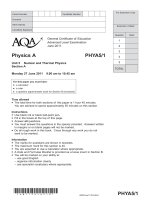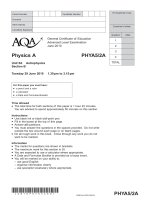AQA PHYA5 2c QP JUN14
Bạn đang xem bản rút gọn của tài liệu. Xem và tải ngay bản đầy đủ của tài liệu tại đây (583.65 KB, 12 trang )
Centre Number
For Examinerʼs Use
Candidate Number
Surname
Other Names
Examinerʼs Initials
Candidate Signature
Question
General Certificate of Education
Advanced Level Examination
June 2014
Mark
1
2
3
Physics A
PHYA5/2C
Unit 5C
Applied Physics
Section B
4
TOTAL
Thursday 19 June 2014 9.00 am to 10.45 am
For this paper you must have:
l a calculator
l a ruler
l a Data and Formulae Booklet (enclosed).
Time allowed
l The total time for both sections of this paper is 1 hour 45 minutes.
You are advised to spend approximately 50 minutes on this section.
Instructions
l Use black ink or black ball-point pen.
l Fill in the boxes at the top of this page.
l Answer all questions.
l You must answer the questions in the spaces provided. Do not write
outside the box around each page or on blank pages.
l Do all rough work in this book. Cross through any work you do not
want to be marked.
l Show all your working.
Information
l The marks for questions are shown in brackets.
l The maximum mark for this section is 35.
l You are expected to use a calculator where appropriate.
l A Data and Formulae Booklet is provided as a loose insert.
l You will be marked on your ability to:
– use good English
– organise information clearly
– use specialist vocabulary where appropriate.
(JUN14PHYA52C01)
WMP/Jun14/PHYA5/2C/E5
PHYA5/2C
Do not write
outside the
box
2
Section B
The maximum mark for this section is 35. You are advised to spend approximately
50 minutes on this section.
1
Figure 1 shows a motor-driven winch for raising loads on a building site. As the motor
turns the cable is wound around the drum, raising the load.
Figure 1
motor
drum
axis
cable
load
The drum, axle and other rotating parts have a moment of inertia about the axis of
rotation of 7.4 kg m2 , and the mass of the load is 85 kg. The drum has a radius of
0.088 m.
The load is accelerated uniformly from rest to a speed of 2.2 m s–1 . When it is
accelerating it rises through a height of 3.5 m. It then continues at the constant speed
of 2.2 m s–1 .
1 (a)
Show that the drum turns through 40 rad as the load accelerates.
[1 mark]
(02)
WMP/Jun14/PHYA5/2C
Do not write
outside the
box
3
1 (b)
Calculate the angular speed of the drum when the load is moving at 2.2 m s–1 .
[1 mark]
angular speed ................................. rad s–1
1 (c) (i)
Show that for the time that the load is accelerating the total increase in energy of the
load and the rotating parts is about 5400 J.
[3 marks]
1 (c) (ii) A constant frictional torque of 5.2 N m acts at the bearings of the winch.
Calculate the total work done by the motor to accelerate the load.
Give your answer to an appropriate number of significant figures.
[3 marks]
total work done ........................................... J
Question 1 continues on the next page
Turn over
(03)
ᮣ
WMP/Jun14/PHYA5/2C
Do not write
outside the
box
4
1 (d)
Calculate the maximum power developed by the motor.
[2 marks]
maximum power ......................................... W
10
Turn to page 6 for the next question
(04)
WMP/Jun14/PHYA5/2C
5
Turn over for the next question
DO NOT WRITE ON THIS PAGE
ANSWER IN THE SPACES PROVIDED
Turn over
(05)
ᮣ
WMP/Jun14/PHYA5/2C
Do not write
outside the
box
6
2
In the sport of sprint cycling rapid acceleration is required.
Discuss the importance of moment of inertia in the design of sport cycle wheels. In
your account you should:
l
l
explain why it is desirable for the wheels to have a low moment of inertia when the
cycle is required to accelerate rapidly
explain the basic features of wheel design which would lead to a low moment of
inertia about the axis of rotation.
The quality of your written communication will be assessed in your answer.
[6 marks]
............................................................................................................................................
............................................................................................................................................
............................................................................................................................................
............................................................................................................................................
............................................................................................................................................
............................................................................................................................................
............................................................................................................................................
............................................................................................................................................
............................................................................................................................................
............................................................................................................................................
............................................................................................................................................
............................................................................................................................................
............................................................................................................................................
............................................................................................................................................
............................................................................................................................................
............................................................................................................................................
............................................................................................................................................
............................................................................................................................................
............................................................................................................................................
(06)
WMP/Jun14/PHYA5/2C
Do not write
outside the
box
7
............................................................................................................................................
............................................................................................................................................
............................................................................................................................................
............................................................................................................................................
............................................................................................................................................
............................................................................................................................................
............................................................................................................................................
............................................................................................................................................
............................................................................................................................................
............................................................................................................................................
............................................................................................................................................
............................................................................................................................................
............................................................................................................................................
............................................................................................................................................
............................................................................................................................................
............................................................................................................................................
6
Turn over for the next question
Turn over
(07)
ᮣ
WMP/Jun14/PHYA5/2C
Do not write
outside the
box
8
3
Figure 2 shows a theoretical engine cycle in which a fixed mass of ideal gas is taken
through the following processes in turn:
A → B: isothermal compression from volume 1.20 × 10–3 m3 and pressure
1.0 × 105 Pa to a volume 0.25 × 10–3 m3 and maximum pressure of
4.8 × 105 Pa.
B → C: expansion at constant pressure with heat addition of 235 J
C → A: adiabatic expansion to the initial pressure and volume at A.
Figure 2
B
4.8
C
pressure / 105 Pa
1.0
0
A
0
0.25 0.39
1.20
volume / 10 –3 m3
3 (a) (i)
Show that process A → B is isothermal.
[2 marks]
3 (a) (ii) Calculate the work done by the gas in process B → C.
[1 mark]
work done ........................................... J
(08)
WMP/Jun14/PHYA5/2C
Do not write
outside the
box
9
3 (b)
Complete Table 1. Apply the first law of thermodynamics to determine values of Q, W
and ΔU for each process and for the whole cycle. Use a consistent sign convention.
[3 marks]
Table 1
Q/J
W/J
process A → B
process B → C
3 (c)
ΔU / J
–188
+235
process C → A
+168
whole cycle
+47
0
The overall efficiency of an engine is defined as
net work output in one cycle
energy supplied by heating from an external source in one cycle
Calculate the overall efficiency of the cycle.
[1 mark]
overall efficiency ..............................................
3 (d)
Describe two problems that would be encountered in trying to design a real engine
based on this cycle.
[2 marks]
............................................................................................................................................
............................................................................................................................................
............................................................................................................................................
............................................................................................................................................
............................................................................................................................................
9
Turn over
(09)
ᮣ
WMP/Jun14/PHYA5/2C
Do not write
outside the
box
10
4 (a)
Explain what is meant by the coefficient of performance of a heat pump.
[1 mark]
............................................................................................................................................
............................................................................................................................................
............................................................................................................................................
............................................................................................................................................
4 (b)
The box labelled E in Figure 3 shows a diagram of a combined heat and power
scheme. The scheme provides electrical energy W from an engine-driven generator
and heat Q1 for buildings situated near to the generator.
Some of the electrical energy is used to drive the heat pump shown in the box
labelled P. Output Q2 is also used to heat the buildings.
Figure 3
E
1600 K
hot space
P
Q2
W
Q1
electrical
energy
290 K
cold space
You may assume that the engine runs at its maximum theoretical efficiency and that
the electrical generator is 100% efficient. The output power of the
engine-driven generator is 80 kW.
(10)
WMP/Jun14/PHYA5/2C
Do not write
outside the
box
11
4 (b) (i)
The fuel used in the engine (E) is propane of calorific value 49 MJ kg–1 . Calculate the
rate of flow of propane into the engine. State an appropriate unit.
[4 marks]
rate of flow ........................ unit ..............
4 (b) (ii) The heat pump has a coefficient of performance of 2.6.
The power supplied by the electrical generator to the heat pump (P) is 16 kW.
Calculate the total rate at which energy is available for heating from both the engine
and heat pump.
[3 marks]
rate at which energy is available ......................................... W
Question 4 continues on the next page
Turn over
(11)
ᮣ
WMP/Jun14/PHYA5/2C
Do not write
outside the
box
12
4 (b) (iii) The conversion of electrical energy to heat is nearly 100% efficient. Explain why the
designer has proposed installing a heat pump rather than an electrical heater to
provide the additional heat Q2 .
[2 marks]
............................................................................................................................................
............................................................................................................................................
............................................................................................................................................
............................................................................................................................................
............................................................................................................................................
10
END OF QUESTIONS
Copyright © 2014 AQA and its licensors. All rights reserved.
(12)
WMP/Jun14/PHYA5/2C









